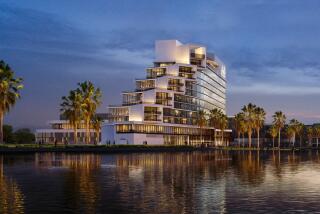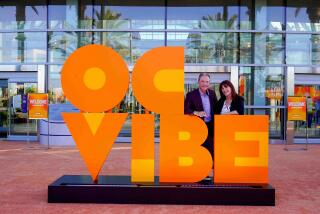Rival Cities Duel Over New Revenues
- Share via
The city of Anaheim, which invested $546 million in public improvements around Disneyland in an effort to create a world-class urban resort stretching beyond Walt Disney Co.’s properties, finds itself several years behind schedule and far short of fulfilling its goals.
The city renovated its Convention Center, refurbished a two-mile area with lush landscaping and new streets and put in other improvements as Disney spent $1.4 billion on an expansion that includes a second theme park next to Disneyland called California Adventure, which is set to open in February.
But Anaheim has failed to attract the high-end hotels, upscale restaurants and entertainment hot spots needed to boost the area’s sagging image.
Those projects are mired in financial and design difficulties, leaving much of the area around the Magic Kingdom still dotted with inexpensive motels, T-shirt shops and fast-food joints.
Nearby Garden Grove, meantime, has stolen some of Anaheim’s thunder by building hotels more quickly and cheaply--picking up “bed” taxes that Anaheim had expected to get.
Anaheim will miss out on more than $6 million a year in new tax revenue it had anticipated, mainly from hotel projects.
“The development is happening. It’s just happening in Garden Grove,” said commercial real estate broker Alan X. Reay, whose Atlas Hospitality Corp. tracks hotel deals. “It’s the area that’s going to reap the benefit of what Anaheim did for Disney.”
With six new hotels less than a mile from Disneyland, Garden Grove has added 1,657 rooms--roughly the extra number Anaheim had expected to have ready next year to take advantage of the predicted crush of tourists that the Disney marketing machine will likely bring to the new park.
Only about 900 rooms have been, or will be, added in and around Anaheim’s resort area.
The delays have worried Anaheim officials enough that they ordered a new financial study to reassess how much revenue the city can expect without the new rooms. They hope existing hotels can increase occupancy levels and raise rates enough to make up the shortfall. The study is due within a month.
City officials concede that the development picture painted three years ago, when they sold $510 million in improvement bonds, was too rosy. They opted, for instance, to rely on a study predicting that 5,550 hotel rooms would be built by 2007, disregarding a separate study saying that the area would attract fewer than half that many by 2005.
But they say that with advance convention center bookings up sharply and Disney’s expansion on target, it’s just a matter of time before their resort fills out.
“We have to draw our timeline out a little. We probably won’t see construction as soon as we want. [But] we really do believe we’ll see quality hotels in the next five to 10 years,” said Jeffrey Stone, Anaheim’s budget manager.
Anaheim’s improvements are designed to lure developers to build unusual attractions for tourists and, most important, new hotels with luxury rooms.
High-priced rooms can improve tax revenue dramatically. Anaheim’s so-called bed tax is 15%, the steepest in California. By contrast, Garden Grove’s bed tax is 10%.
Anaheim got its chance to upgrade the seedy sideshow surrounding much of Disneyland in the early 1990s when it built Arrowhead Pond about two miles away and beat out Long Beach as the site for Disney’s second West Coast theme park.
The aim was to become a “multidimensional travel resort” instead of a “one-dimensional tourist stop,” Deputy City Manager Tom Wood said. The lavish improvements create “upside potential” for more development, he said--even if it takes longer to arrive than officials had hoped.
Four years ago, the city-sponsored proposal for Sportstown on the Edison Field parking lot envisioned hotels, shops, offices, orchards, a produce market, youth sports fields, a Western village with a rodeo arena and a monorail extension from Disneyland. Tinseltown Studios, an Oscars-style dinner theater, was the only entertainment project built, and it failed. The building is being leased for concerts as Sun Theatre.
Gotcha Glacier, a $130-million indoor sports center, is the latest proposal for the site. But design and financing snags have stalled it. The facility would house a snowboarding slope, an ice rink, wave pools and areas for skateboarding, rock climbing and skydiving.
The biggest proposal is Pointe Anaheim, a $500-million entertainment mall with three full-service hotels across Harbor Boulevard from Disneyland. Like Gotcha Glacier, Pointe Anaheim was to open at the same time as Disney’s new park. But partly because of Disney objections to its design, the project took a year longer than anticipated to gain city approval.
As time wore on, lenders have become inclined to wait to gauge Disney’s success before funding another major development.
“I think everyone is waiting to see now what happens with the second gate,” said Disney board member Raymond L. Watson, vice chairman of Orange County developer Irvine Co. “And why not wait?”
Garden Grove was quick to see the opportunities years ago, and put together an enticing package for hotel developers.
The city looked at industry studies predicting that several thousand new hotel rooms would be needed with Anaheim’s and Disney’s expansions, said Matthew Fertal, Garden Grove’s director of community development.
The city saw that high land costs near Disneyland would make it difficult for Anaheim to build affordable hotels. Most vacationers don’t want to pay a lot for lodging, Fertal said.
Scraping together $35 million, and at one point threatening to take over a senior citizens’ trailer park through eminent domain, Garden Grove purchased 28 acres of land barely a mile down the road from Disneyland and the Anaheim Convention Center.
Fertal and his staff spent two years hunting developers and begging them to consider building there. They succeeded in attracting six moderate-priced hotels with 1,657 rooms. An additional 280 rooms and suites likely will be added to the existing Hyatt Alicante hotel next door.
“If we were going to capture any of it, we wanted the first 2,000 rooms, not the tail end, because we are a little farther away,” Fertal said. “We had to be extra aggressive. No one came to Garden Grove and said, ‘We want to build a hotel.’ ”
He doesn’t think visitors will mind that they’re not actually in Anaheim.
Reay said that had those new hotels been built in Anaheim, they would have generated $5.6 million a year in taxes--nearly the entire extra revenue Anaheim had anticipated.
In return for free land and tax rebates over seven years, the developers are required to keep the hotels operating while Garden Grove recovers its land costs through new tax revenue.
The new hotel rooms will cost from about $85 to about $120 a night, Fertal said. That’s far below the $250 minimum price posted at Disney’s Grand Californian, being built inside the new park, but more than many of Anaheim’s existing tourist motels.
Garden Grove also has tried to encourage growth down the gritty stretch of Harbor Boulevard just south of its new hotel district. A proposal for an entertainment mall called Riverwalk proved unworkable, but Fertal said the city would still be eager to redevelop the area if an entertainment-oriented project appeared feasible.
From Anaheim’s perspective, “it seems like Garden Grove pretty much gave away the store,” said Bret Colson, Anaheim’s spokesman.
Anaheim isn’t contemplating similar favors to developers. “We’ve provided them a half-billion [dollars] in incentives already with the new convention center and all the new landscaping and infrastructure improvements,” he said.
Anaheim Mayor Tom Daly said Garden Grove’s hotels, which replaced several eyesores in that city, may work out as a complement to Anaheim’s plans in the end.
“It helps if the town next door is clean. If it makes money and they spend it on their city, that’s good. They need parks and libraries just like we do,” Daly said.
For Disney, which aims to duplicate its success in attracting tourists to Florida for days on end, the lack of nearby hotel and entertainment competition could be a boon.
Its $1.4-billion expansion includes a $159-million shopping and entertainment zone called Downtown Disney and the $186-million luxury Grand Californian hotel, which Disney expects will skim the cream off the Anaheim visitor market.
If hotel demand proves heavy, Disney already has city approval to add 250 rooms to the 750 under construction. And in briefings to workers, it has disclosed tentative plans to build its own less-expensive hotels nearby.
Much of Anaheim’s spending paid for improvements that directly benefit Disney, including $90 million for the massive five-story garage. Disney will operate the 10,000-car parking structure and keep the profits.
*
Times correspondent Judy Silber contributed to this story.
(BEGIN TEXT OF INFOBOX / INFOGRAPHIC)
Border Battle
Many non-Disney developments proposed around Disneyland in Anaheim have stalled, while neighboring Garden Grove has moved quickly to build a strip of hotels in its Harbor Boulevard corridor. A look at the status of the projects: *
*
Hotels in Garden Grove’s Harbor Boulevard district that are new or under construction:
*--*
HOTEL ROOMS Embassy Suites 372 Marriott Renaissance 371 Crowne Plaza 384 Homewood Suites 203 Hampton Inn & Suites 165 Hilton Garden Inn 162
*--*
Sources: Atlas Hospitality Group, Garden Grove Agency for Community Development, Times reports
More to Read
Inside the business of entertainment
The Wide Shot brings you news, analysis and insights on everything from streaming wars to production — and what it all means for the future.
You may occasionally receive promotional content from the Los Angeles Times.











